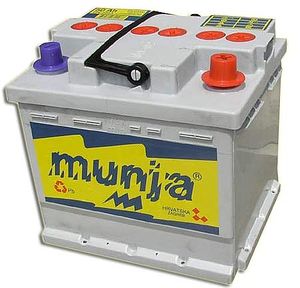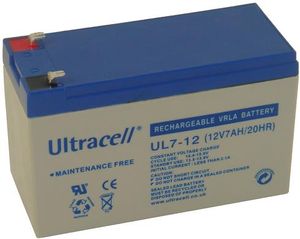Difference between revisions of "Lead acid battery"
(pics & starting battery) |
(→SLAs: pic fix) |
||
| Line 18: | Line 18: | ||
===SLAs=== | ===SLAs=== | ||
| − | [[image:UL20712.jpg|thumb|SLA battery]] | + | [[image:UL20712-2.jpg|thumb|SLA battery]] |
'''S'''ealed '''L'''ead '''A'''cid batteries are spillproof, and don't have to be kept upright at all times. The liquid electyrolyte is held in place using gel or glass fibre mats, and a catalyst recombines the H2 and O2 produced during overcharge. | '''S'''ealed '''L'''ead '''A'''cid batteries are spillproof, and don't have to be kept upright at all times. The liquid electyrolyte is held in place using gel or glass fibre mats, and a catalyst recombines the H2 and O2 produced during overcharge. | ||
While this is a boon for some apps, they do have downsides. They can only be slow charged at 13.6v. When they eventually dry out - which they often do - topping up is impossible. They have shorter life expectancy than a properly maintained unsealed battery - though longer life than an unmaintained unsealed battery. | While this is a boon for some apps, they do have downsides. They can only be slow charged at 13.6v. When they eventually dry out - which they often do - topping up is impossible. They have shorter life expectancy than a properly maintained unsealed battery - though longer life than an unmaintained unsealed battery. | ||
| − | |||
==Performance== | ==Performance== | ||
Revision as of 06:39, 28 June 2008
Lead acid batteries are the lowest cost per capacity rechargeable batteries, and are widely used as vehicle and power backup batteries. DIY applications include alarm power supplies, UPSes, emergency Lighting, offgrid power generation, and other power backup applications.
Types
Lead acid batteries are widely available from 2Ah to around 100Ah in 6v, 12v and 24v batteries. Specialists can supply almost any voltage and capacity required.
Starting battery
Optimised for high engine cranking current, these are widely used in cars & trucks. They are not very tolerant of deep discharge, and repeated discharge causes premature failure. The batteries spill acid if tipped.
Deep discharge
Some lead acid batteries are intended for deep discharge. These use bulk plates with all the anode on one side and cathode on the other. Leisure batteries are deep discharge type.
Car batteries are not suitable for deep discharge. If deep discharged they have short lives. These have alternating plates closely spaced, and are optimised for high current delivery.
Car batteries are not suited to offgrid power use. Many have tried and they don't last well, if discharged to 10.8v as usual. Its possible to use them by substantially increasing the capacity, and stopping discharge at well above the usual voltage, but deep discharge batteries can be expected to last longer.
SLAs
Sealed Lead Acid batteries are spillproof, and don't have to be kept upright at all times. The liquid electyrolyte is held in place using gel or glass fibre mats, and a catalyst recombines the H2 and O2 produced during overcharge.
While this is a boon for some apps, they do have downsides. They can only be slow charged at 13.6v. When they eventually dry out - which they often do - topping up is impossible. They have shorter life expectancy than a properly maintained unsealed battery - though longer life than an unmaintained unsealed battery.
Performance
Voltage
Fully charged cell terminal voltage is 2.2v, giving over 13v for a nominally 12v battery. This voltage declines in use, and discharge should be stopped at 10.8v, giving an average of 12v. Discharge to lower voltage reduces battery life.
Current
Lead acid cells are generally capable of delivering huge currents, and thus can be used for starting vehicles and generators, spot welding, heavy power backup and so on.
Capacity
Capacity is described in amphours (Ah). 20Ah means a battery can supply 1A for 20 hours. This battery could also supply approx 2A for 10 hours. Capacity is almost a constant, but faster discharge reduces capacity to some degree. So if our example battery were discharged at 10A, it would fall a bit short of 2 hours run time. Rated amphour capacity is measured for a 20hr discharge. Rated capacity describes output, not input.
Energy
The energy a battery can supply is its capacity multipled by terminal voltage. Thus a 12v 30Ah battery could supply 12v x 30Ah = 360 watt hours, or 0.36 kWh.
Energy efficiency
Energy Efficiency of lead acids is around 75%. This means 100 watt hours in will yield around 75 watt hours out. Energy efficiency is maximised by using a slow charge.
Life expectancy
Life depends on how long the battery spends flat. Lead acids don't survive well when left flat, and this should never be done if possible.
Life also depends on how deeply the battery is discharged. A battery discharged 50% lasts longer than one discharged 80%, which lasts much longer than one discharged 95%.
Life also depends on maintenance. Batteries need an occasional top up with deionised water, and less often acid needs to be added to restore electrolyte strength. Lead acids are often used without any maintenance, but last rather longer when attention is paid to their basic needs.
Storage
Batteries not in use should be recharged monthly. If not in use for a long time the battery should be drained, rinsed quickly and dried. Dry they should store indefinitely.
Safety
Fire
Lead acid cells are typically capable of delivering huge currents, and the resultant fire risk is very real. In any application a fuse should be fitted close to the battery to prevent fire in case of a short.
Acid
Most lead acids will spill acid if tipped. Goggles should be worn if moving open topped cells due to the likelihood of splash. Acid can burn skin and eyeballs, and awareness of the safety issues is required when handling battery acid. Baking soda and water can be kept to hand in case of spill.
Hydrogen
During charging, lead acids give off hydrogen and oxygen gases. Normally this explosive mixture mixes with surrounding air rendering it safe. However in some unusual situations the gases can build up and cause a small explosion. A little ventilation should always be provided to prevent any chance of this occurring.
Choking
Batteries grossly overcharged can reach boiling point, and emit clouds of sulphuric acid laden steam. This requires excess current rather than excess charge time, several 10s of amps for a typical car battery. Its not a fun situation to be in, and I speak from experience. Most applications don't include charging apparatus capable of delivering enough power to do this, but where they do and the battery lives indors, a safeguard should be present to prevent gross overcharge. A fuse or thermal breaker on the charger can be effective.
Weight
Large lead acid cells can cause back injury on lifting, or broken foot bones if dropped. Very heavy cells can be kept at floor level during moving, using plywood on castors to move them, or the cells can be constructed in situ. Very large purchased cells may be moved with a hand forklift truck.
Charging
Charge rate is usually expressed as the ratio of charge current to capacity. For example C/20 is the rate at which it takes 20 hrs to charge, C/10 takes 10 hrs etc.
Crude chargers can be used at rates of C/20 or longer. The faster charging is desired, the more control the charger needs to exert to avoid battery damage. Smart chargers enable faster charging without risk to the battery.
Lead acids are charged using a constant voltage.
- Unsealed 12v batteries may be charged at 14.4v.
- SLAs should not be charged at above 13.6v, resulting in slow charges.

